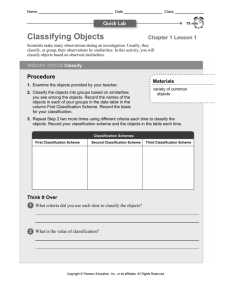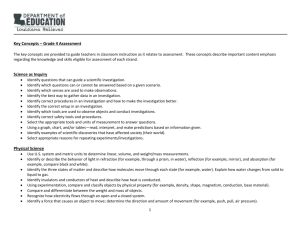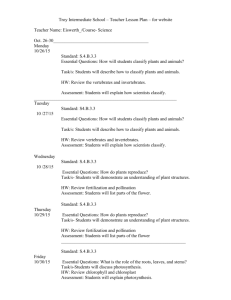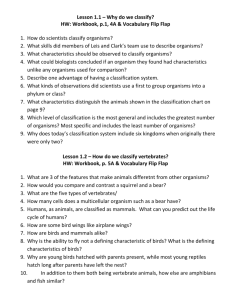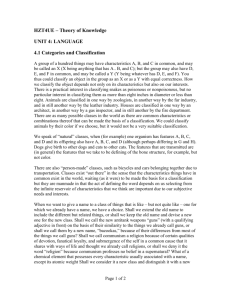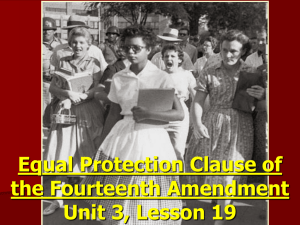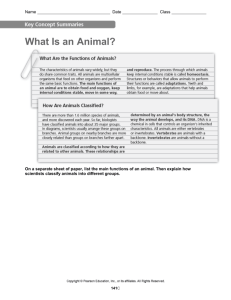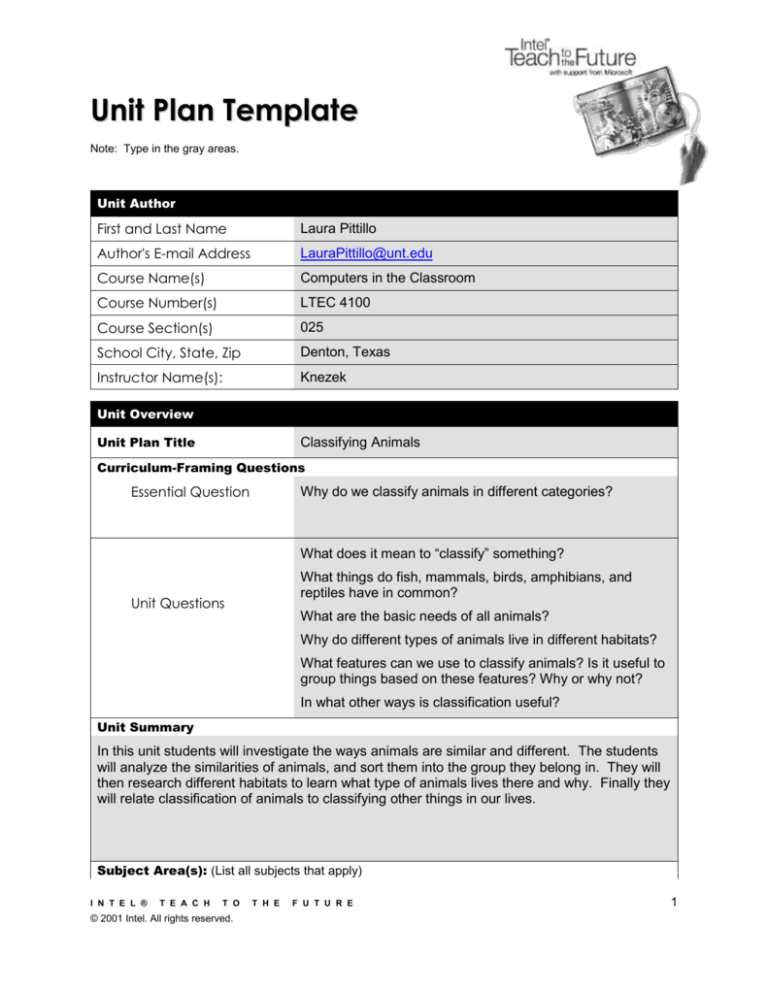
Unit Plan Template
Note: Type in the gray areas.
Unit Author
First and Last Name
Laura Pittillo
Author's E-mail Address
LauraPittillo@unt.edu
Course Name(s)
Computers in the Classroom
Course Number(s)
LTEC 4100
Course Section(s)
025
School City, State, Zip
Denton, Texas
Instructor Name(s):
Knezek
Unit Overview
Unit Plan Title
Classifying Animals
Curriculum-Framing Questions
Essential Question
Why do we classify animals in different categories?
What does it mean to “classify” something?
What things do fish, mammals, birds, amphibians, and
reptiles have in common?
Unit Questions
What are the basic needs of all animals?
Why do different types of animals live in different habitats?
What features can we use to classify animals? Is it useful to
group things based on these features? Why or why not?
In what other ways is classification useful?
Unit Summary
In this unit students will investigate the ways animals are similar and different. The students
will analyze the similarities of animals, and sort them into the group they belong in. They will
then research different habitats to learn what type of animals lives there and why. Finally they
will relate classification of animals to classifying other things in our lives.
Subject Area(s): (List all subjects that apply)
I N T E L ®
T E A C H
T O
© 2001 Intel. All rights reserved.
T H E
F U T U R E
1
Science, Technology
Grade Level (Click boxes of all grade levels that apply)
K-2
6-8
ESL
Gifted and Talented
I N T E L ®
T E A C H
T O
© 2001 Intel. All rights reserved.
3-5
9-12
Resource
Other:
T H E
F U T U R E
2
UQ Student Objective/Learning
#
Outcome
Targeted State
Standard/Benchmark
Discuss what it means to
classify something.
What does it mean to “classify”
something?
What things do fish, mammals, birds,
amphibians, and reptiles have in
common?
What features can we use to classify
animals? Is it useful to group things
based on these features? Why or
why not?
I N T E L ®
T E A C H
T O
© 2001 Intel. All rights reserved.
T H E
Procedures/Activities
§112.12. Science, Grade 1
(b) Knowledge and skills.
(9) Organisms and
environments. The student
knows that the living
environment is composed of
relationships between
organisms and the life cycles
that occur. The student is
expected to:
(A) sort and classify living and
nonliving things based upon
whether or not they have basic
needs and produce offspring;
Introduce and discuss
characteristics of fish,
mammals, birds, amphibians,
and reptiles. Discuss
similarities and differences.
Watch a video about the
different types of animals.
Complete a worksheet
together about classification.
Throughout the week the
children can visit websites to
play games and watch lessons
on animal classification.
§126.2. Technology
Applications, KindergartenGrade 2.b) Knowledge and
skills.
(4) Information acquisition. The
student uses a variety of
strategies to acquire
information from electronic
resources, with appropriate
supervision. The student is
expected to:
(A) apply keyword searches to
acquire information; and
(B) select appropriate
strategies to navigate and
access information for research
and resource sharing.
(5) Information acquisition. The
student acquires electronic
information in a variety of
formats, with appropriate
supervision. The student is
expected to:
(A) acquire information
Put students in 5 groups and
assign them a category. Then
have each student print a
picture of an animal they think
belongs in that category.
Have them discuss with their
group what features of the
animal lead them to their
decision.
F U T U R E
3
including text, audio, video, and
graphics; and
What are the basic needs of all
animals?
Why do different types of animals live
in different habitats?
§112.12. Science, Grade 1
(b) Knowledge and skills.
(9) Organisms and
environments. The student
knows that the living
environment is composed of
relationships between
organisms and the life cycles
that occur. The student is
expected to:
(A) sort and classify living and
nonliving things based upon
whether or not they have basic
needs and produce offspring;
Make a list with the class of
animal’s different needs.
§112.12. Science, Grade 1
(b) Knowledge and skills.
(10) Organisms and
environments. The student
knows that organisms resemble
their parents and have
structures and processes that
help them survive within their
environments. The student is
expected to:
(A) investigate how the
external characteristics of an
animal are related to where it
lives, how it moves, and what it
eats;
Use the list of animals needs
to have children figure out why
different animals live in
different habitats. Have the
groups choose a habitat to go
with their category. They can
then decorate a poster like
that habitat and draw animals
on it. Then have the children
present to the class.
In what other ways is classification
useful?
I N T E L ®
T E A C H
T O
© 2001 Intel. All rights reserved.
T H E
F U T U R E
Finally, talk to the class about
why it is useful to classify
animals. Then discuss other
things you can classify into
groups. Such as things in
your desk. The students can
then clean and classify their
messy desks.
4
Approximate Time Needed (Example: 45 minutes, 4 hours, 1 year, etc.)
Forty minutes a day for one week.
Prerequisite Skills
Basic skills they should have acquired in lower grades: reading, writing, internet use, cutting
and glueing.
Materials and Resources Required For Unit
Technology – Hardware (Click boxes of all equipment needed.)
Camera
Laser Disk
Computer(s)
Printer
Digital Camera
Projection System
DVD Player
Scanner
Internet Connection
Television
VCR
Video Camera
Video Conferencing Equip.
Other:
Technology – Software (Click boxes of all software needed.)
Database/Spreadsheet
Image Processing
Desktop Publishing
Internet Web Browser
E-mail Software
Multimedia
Encyclopedia on CD-ROM
Web Page Development
Word Processing
Other:
Printed Materials
Worksheets
Supplies
Scissors, glue, pencil, colors, poster board, computer, and
printer.
Internet Resources
Websites with games and lessons, search engine to find
pictures.
Accommodations for Differentiated Instruction
Others
Resource Student
Pair with a group that is willing to help them understand the
lesson. Also provide assistance with computer work.
Gifted Student
Have gifted students create a brochure about one of the
classifications of animals.
Student Assessment
Evaluate the students’ understanding of the classification of animals and their habitats by
reviewing their posters with them.
I N T E L ®
T E A C H
T O
© 2001 Intel. All rights reserved.
T H E
F U T U R E
5

